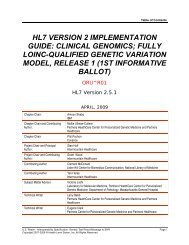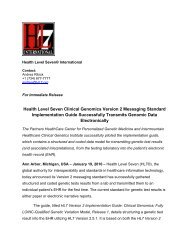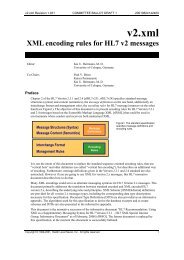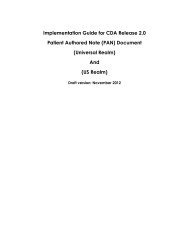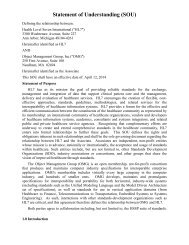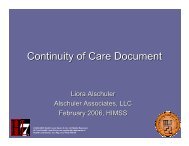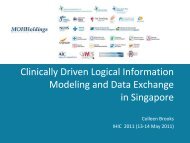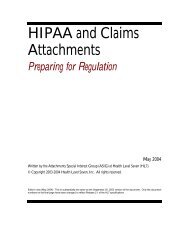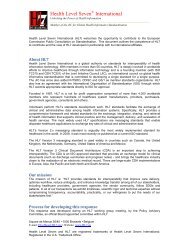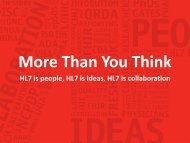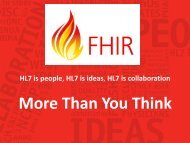HL7 CDA R2 AIS Implementation Guide
HL7 CDA R2 AIS Implementation Guide
HL7 CDA R2 AIS Implementation Guide
Create successful ePaper yourself
Turn your PDF publications into a flip-book with our unique Google optimized e-Paper software.
<strong>HL7</strong> Additional Information Specification <strong>Implementation</strong> <strong>Guide</strong><strong>CDA</strong><strong>R2</strong><strong>AIS</strong>0000R030accessible outside of the clinical information system that created the document. When the <strong>CDA</strong>document is sent via attachments, these URLs may no longer be accessible by the receivinginformation system. Therefore, each content item that is referenced by a URL within the <strong>CDA</strong>document must be included as a content item in the MIME package. Each content item mayspecify the URL by which it is known using the Content-Location header. The receiver of thisMIME package shall translate URL references according to the RFC-2557. This will ensureresolution of the original URL to the correct content item within the MIME package. Thus, URLreferences contained within an original document need not be rewritten when the <strong>CDA</strong> package istransmitted. Instead, these URLs are simply supplied as the value of the Content-Location headerin the MIME package. RFC 2557 can be accessed at: http://www.faqs.org/rfcs/rfc2557.html.This capability allows for the same content item to be referred to more than once in a MIMEmultipart/related package without requiring the content item to be supplied multiple times.However, it does not allow a separate MIME multipart/related package to contain references toinformation sent in a previously recorded package.2.4.3 Referencing documents from other multiparts within the same X12 transactionRFC-2392 is used when referencing content across MIME package boundaries, but still containedwithin the same X12 transaction (ST to SE). This can occur when the same document is used toanswer multiple questions for a single claim. Each component of a MIME package may beassigned a content identifier using the Content-ID header for the content item. For example, thisheader would appear as:Content-ID: This content identifier is a unique identifier for the content item, which means it must never beused to refer to any other content item 4 . RFC-2392 defines the Content ID (cid:) URL scheme(http: and ftp: are two other URL schemes). This URL scheme allows for references by theContent-ID header to be resolved. The URL for the content item identified above would be:cid:07EE4DAC-76C4-4a98-967E-F6EF9667DED1Receivers of the MIME multipart message must be able to resolve a cid: URL to the content itemthat it identifies. Senders must ensure that they only refer to items that have already beentransmitted to the receiver by their cid: URL. Thus, this implementation guide prohibits forwardURL references using the cid: URL scheme. RFC 2392 can be accessed at:http://www.faqs.org/rfcs/rfc2392.html.Content items shall not be referenced across X12 transactions using the cid: URL scheme. Forexample, if the payer previously requested information using a 277, and the provider returned thatinformation in a MIME multipart/related package in a 275, and then the payer requestedadditional information in another 277, the provider may not refer to the content item previouslyreturned in the prior 275 transaction.4 The example above uses a GUID (globally unique identifier), which is a random stream of bytes that is almostguaranteed to be unique.Copyright © 1998-2007 Health Level Seven, Inc. All rights reserved.Release 3.0 Draft StandardPage 17March 2007




